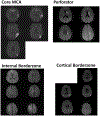Hemodynamic Markers in the Anterior Circulation as Predictors of Recurrent Stroke in Patients With Intracranial Stenosis
- PMID: 30580705
- PMCID: PMC6559874
- DOI: 10.1161/STROKEAHA.118.020840
Hemodynamic Markers in the Anterior Circulation as Predictors of Recurrent Stroke in Patients With Intracranial Stenosis
Abstract
Background and Purpose- Although aggressive medical therapy was superior to stenting in the SAMMPRIS trial (Stenting and Aggressive Medical Management for Preventing Recurrent Stroke in Intracranial Stenosis), the stroke rate in the medical arm was still high. The aim of this study was to determine the association between hemodynamic markers (borderzone infarct pattern and impaired collateral flow on baseline imaging) and rates of recurrent stroke in patients treated medically in SAMMPRIS. Methods- This was a post hoc analysis of patients whose qualifying event for SAMMPRIS was an infarct in the territory of a stenotic middle cerebral artery or intracranial carotid artery. Infarcts were adjudicated as involving primarily internal or cortical borderzone territories, the core middle cerebral artery territory, or perforator territories, and collateral flow was assessed according to a standard scale (American Society of Interventional and Therapeutic Neuroradiology/Society of Interventional Radiology). Log-rank tests and χ2 tests were performed to assess associations of infarct patterns and collateral flow with rates of recurrent stroke. Results- Of 101 patients who qualified, 14 of 53 (26.4%) with borderzone infarcts, 2 of 24 (8.3%) with core middle cerebral artery infarcts, and 3 of 24 (12.5%) with perforator infarcts had a recurrent stroke in the territory (P=0.14 for comparing the 3 groups, P=0.052 for borderzone versus nonborderzone). Of 82 patients with collateral flow assessment, 30 of 43 (70%) with borderzone infarcts, 7 of 19 (37%) with core middle cerebral artery infarcts, and 11 of 20 (55%) with perforator infarcts had impaired collateral flow distal to the stenosis (P=0.049). Patients with borderzone infarcts and impaired collateral flow had the highest risk of recurrent stroke (37%). Conclusions- Borderzone infarcts and impaired collateral flow identify a subgroup of patients with intracranial stenosis who are at particularly high risk of recurrent stroke on medical treatment. Clinical Trial Registration- URL: https://www.clinicaltrials.gov. Unique identifier: NCT00576693.
Keywords: angioplasty; atherosclerosis; hemodynamic; middle cerebral artery.
Figures


Comment in
-
Letter by Reale et al Regarding Article, "Hemodynamic Markers in the Anterior Circulation as Predictors of Recurrent Stroke in Patients With Intracranial Stenosis".Stroke. 2019 May;50(5):e129. doi: 10.1161/STROKEAHA.118.024760. Stroke. 2019. PMID: 30890113 No abstract available.
References
-
- Gorelick PB, Wong KS, Bae HJ, Pandey DK. Large artery intracranial occlusive disease: A large worldwide burden but a relatively neglected frontier. Stroke. 2008;39:2396–2399 - PubMed
-
- Arenillas JF. Intracranial atherosclerosis: Current concepts. Stroke. 2011;42:S20–23 - PubMed
-
- Kasner SE, Chimowitz MI, Lynn MJ, Howlett-Smith H, Stern BJ, Hertzberg VS, et al. Predictors of ischemic stroke in the territory of a symptomatic intracranial arterial stenosis. Circulation. 2006;113:555–563 - PubMed
-
- Tsivgoulis G, Vadikolias K, Heliopoulos I, Katsibari C, Voumvourakis K, Tsakaldimi S, et al. Prevalence of symptomatic intracranial atherosclerosis in caucasians: A prospective, multicenter, transcranial doppler study. J Neuroimaging. 2014;24:11–17 - PubMed
Associated data
Grants and funding
LinkOut - more resources
Full Text Sources
Medical

